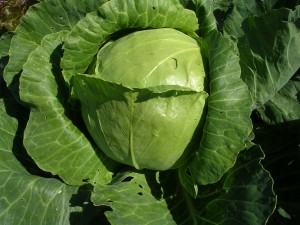I have to admit, I’m not a big cabbage (Brassica oleracea) fan. I’ve grown and eaten it for years and certainly it’s one of those easiest, tried and true vegetables to grow. The cabbage types that do attract my attention are the red and savoy (wavy leaves) varieties. They’re beautiful in the garden, have a sweeter flavor and add color and texture to salads and sautes. Whether you’re growing g reen or red, smooth leaved or savoy leaf, cabbages are good way to get a lot of vegetable in a small space. Varieties range in size from single serving 1 pounders to whopping 8 pound heads. That’s a lotta slaw and kraut! Select early, mid, and late season varieties to extend your cabbage season from spring to fall.
reen or red, smooth leaved or savoy leaf, cabbages are good way to get a lot of vegetable in a small space. Varieties range in size from single serving 1 pounders to whopping 8 pound heads. That’s a lotta slaw and kraut! Select early, mid, and late season varieties to extend your cabbage season from spring to fall.
When to Plant
Cabbages love it cool, so aim for a spring and fall crop. Unless you’re growing cabbage for making lots of cole slaw or kraut, there’s no need to plant lots of cabbages. It’s best to stagger the planting in spring to have a few cabbages maturing each week. Sow seeds indoors 5 to 7 weeks before your last frost and transplant these seedlings, or ones purchased at the garden center, 3 weeks later. For fall, plant seedlings in late summer. Cabbage can withstand a frost and still grow. Cabbage likes to mature during cool weather. Keep this vegetable well watered to prevent the head from cracking.
In general, they grow best with temperatures below 80F. If cabbage is trying to mature during the heat of summer, it may bolt (go to flower and not form a head).
Where to Plant
Cabbages grow best in full sun on well drained fertile soil. Amend the soil generously with compost prior to planting.
How to Plant
Plant seedlings 24 inches apart in rows 3 feet apart. Smaller varieties such as ‘Dynamo’ can be planted closer together. Consider planting fast maturing radishes, mesclun mix, or lettuces around cabbages in spring. These will mature before the cabbages get too big to crowd them out. It’s a great way to save space in small garden.
Care and Maintenance
Cabbages love constant water and little competition from weeds. After plants are established, mulch with an organic material such as straw or untreated grass clippings. This will help control weeds and maintain the soil moisture. Add a small handful of a high nitrogen fertilizer, such as soybean meal or fish emulsion, per plant about 1 month after planting. Don’t fertilize after that because it may cause the heads to grow too fast and crack open. Cracked heads are an open invitation to disease.
Diseases, such as fusarium wilt and black rot, can stunt and kill cabbages and are especially prevalent on heavy soils and during rainy periods. Select resistant varieties if this is a problem. Young seedling may fall victim to cutworms in spring. Protect transplants by wrapping a 3-inch-thick strip of newspaper around the stem, keeping it 2 inches above the ground and 1 inch below. Like other cabbage-family crops, cabbageworms and cabbage loopers are major pests. Check in early summer for green worms eating the leaves and spray an organic pesticide containing Bacillus thuriengensis (Bt) on plants to control them.
Harvest
Harvesting cabbage by the “feel” method. This is fun. Squeeze the heads once they’re full size. If firm, cut it off just below the head with a sharp knife. Remove the outer “wrapper” leaves to reveal the main head. Don’t pull up the plant. For spring planted cabbages, you may get two smaller heads forming later in the summer. Try to harvest before a heavy rain. A quick influx of water can cause the head to crack open.
Additional Information
‘Gonzales Hybrid’ and ‘Farao Hybrid’ are two good green, smooth-headed varieties. ‘Red Express’ is a nice red variety. ‘Caraflex Hybrid’ is an unusual cone-shaped green variety that has small, 2 pound heads and tender leaves. ‘Famosa Hybrid’ is a good savoy variety.
Text excepted from the Northeast Vegetable and Fruit Gardening book.


